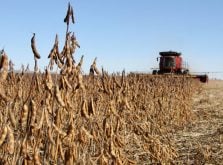Canada’s pride in having ‘the safest food in the world’ is based on rhetoric, not fact, says a University of Manitoba professor.
After examining the data on the frequency of food borne illness, Rick Holley found Canada’s frequency of E. coli infections was 2.5 people per 100,000 in 2007, double the rate of infection of 1.3 per 100,000 in the United States. And when Canadian data was compared to 35 countries in Europe, Holley learned that 80 percent of EU countries have fewer E. coli infections per 100,000 people.
“That’s not a characteristic of a country that claims to be the safest in the world,” said Holley, a U of M food science professor who specializes in food pathogens.
Read Also

Manitoba extends Crown land rent freeze
Manitoba government links the continued rental rate freeze on grazing and forage leases to economic and environmental challenges facing the industry
Holley presented his findings at a March 19 agricultural seminar at the U of M. He told an audience of students, professors and food industry representatives that Canada also has higher rates of salmonella and campylobacter infection than the U.S. and dozens of EU countries. Campylobacter is a bacterium commonly found in poultry. It can cause diarrhea and fever.
Overall, food borne viruses and bacteria cause about 11 to 13 million cases of food poisoning in Canada every year, according to Health Canada. Many cases go unreported.
The primary weakness with the Canadian system, according to Holley, is surveillance.
“It’s a passive system in Canada and it does not collect all the information out there.”
Holley has published more than 140 papers on food microbiology. He specializes in the safety of meat.
Most importantly, there is no national system to report enteric outbreaks, whether it is E. coli in ground beef or salmonella in chocolate, he said.
“As a result of cutbacks at Health Canada in 1996, they raided the surveillance program.”
Holley is not alone in his criticism of Canada’s data collection and tracking programs.
“There’s no really good surveillance, whereas the U.S. is second to none in that,” said Keith Warriner, an associate professor at the University of Guelph’s food science department specializing in vegetable pathogens.
He said people hospitalized in Canada with salmonella, for example, are not recorded in a registry, while they are in the U.S.
He added that Canada’s food system is not bad, but Canadian’s sense of how effective it is may be inflated.
“We might overestimate how effective it is … we don’t know how many people do get ill.”
Holley said establishing a high quality surveillance system is the most important step in fixing problems with food safety.
“The surveillance would lead to the development of data that would show which of these organisms is problematic in which foods,” he said.
“You put the surveillance program in place to tell you what’s wrong. And then you put a program in place to address those ills.”
Three federal bodies work together to ensure the safety of Canadian food: Health Canada; the Public Health Agency of Canada; and the Canadian Food Inspection Agency.
Paul Duchesne, a spokesperson for Health Canada, said the CFIA looks at the marketplace and looks for products that might fail to meet Health Canada regulations.
The Public Health Agency of Canada works with local public health units to track trends or possible outbreaks. He said if they see 50 cases of salmonella in Winnipeg, then something must be going on.
Then public health would work with CFIA to issue a recall, if needed, and discover the root of the Winnipeg outbreak. Health Canada, oversees the monitoring system, setting guidelines and regulations.
CFIA spokesperson Mark Clarke said most of the 12 million cases of food borne illness each year in Canada are caused by poor food preparation methods, most often in the home.
As well, the number of food recalls in Canada has been steady at around 100 per year for several years, Clarke said, meaning the system is working.
“If you compare that to the sheer volume of food that is imported to, or produced in Canada, that’s a very low rate of problem,” he said.
Holley said his criticisms are not attacks at federal agencies, but represent an attempt to move past slogans and improve the system.
This year, the federal government took steps to improve the system, increasing the CFIA’s budget to $523 million from $380 million in 2007.
But Holley said inspection alone will not solve the causes of food poisoning.
Warriner said more inspection is helpful, but more needs to be done.
“The CFIA is underfunded, compared to the U.S. for sure,” said Warriner. “The number of inspectors we have is much less than the U.S. per capita.”
With more inspectors, the CFIA could better monitor smaller processors, which are often the source of outbreaks, he said.
Processors must insure food is safe and must be held legally responsible, he said, which is a key reason why the U.S. has developed superior illness tracing systems.
“The thing that spurred them on is litigation,” said Warriner. “The litigation in food borne illness cases is unbelievable (in the U.S).”
In contrast, Canadians are less likely to jump in their car and drive to the lawyer’s office after eating a bad burger, he said.















